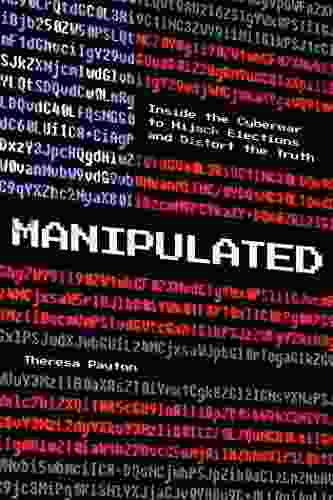Inside the Cyberwar to Hijack Elections and Distort the Truth

4.7 out of 5
| Language | : | English |
| File size | : | 982 KB |
| Text-to-Speech | : | Enabled |
| Screen Reader | : | Supported |
| Enhanced typesetting | : | Enabled |
| Word Wise | : | Enabled |
| Print length | : | 198 pages |
In the 2016 U.S. presidential election, Russian hackers infiltrated the computer systems of the Democratic National Committee and stole a trove of emails that were later released in a series of damaging leaks. This was just one example of the growing threat of cyberwarfare, in which nation-states and other actors use cyberattacks to influence elections, spread propaganda, and destabilize their adversaries.
Cyberwarfare is not new, but it has become increasingly sophisticated and dangerous in recent years. The rise of the internet and social media has made it possible for attackers to reach a global audience with their messages. At the same time, the increasing interconnectedness of our world has made us more vulnerable to cyberattacks.
The 2016 U.S. election was a watershed moment in the history of cyberwarfare. It was the first time that a foreign government had successfully interfered in a U.S. election through cyberattacks. The Russian government's hacking and leaking of emails from the Democratic National Committee and Hillary Clinton's campaign chairman, John Podesta, had a significant impact on the election. The leaks helped to damage Clinton's reputation and sow discord among her supporters. They also gave Russian President Vladimir Putin a platform to spread propaganda and disinformation about the election.
The 2016 election was not an isolated incident. In recent years, there have been a number of other cases of cyberwarfare being used to influence elections. In 2017, Russian hackers targeted the French presidential election. In 2018, Russian hackers targeted the midterm elections in the United States. And in 2019, Iranian hackers targeted the Israeli parliamentary election.
Cyberwarfare is not just a threat to democracy. It is also a threat to our national security. Cyberattacks can be used to cripple critical infrastructure, such as power grids and water systems. They can also be used to steal sensitive information, such as military secrets and trade secrets.
The United States and other countries are taking steps to address the threat of cyberwarfare. They are investing in new technologies to defend against cyberattacks. They are also working to strengthen international cooperation on cybersecurity. However, there is still much that needs to be done to protect ourselves from this growing threat.
How Cyberwarfare Works
Cyberwarfare is the use of cyberattacks to achieve political or military objectives. Cyberattacks can take many forms, including:
- Hacking into computer systems to steal data or disrupt operations
- Spreading malware to damage computer systems or networks
- Launching denial-of-service attacks to overwhelm computer systems or networks with traffic
- Manipulating social media to spread propaganda or disinformation
Cyberwarfare can be used to target a wide range of targets, including:
- Government agencies
- Military targets
- Critical infrastructure
- Businesses
- Individuals
Cyberwarfare can have a devastating impact on its targets. It can disrupt critical services, damage economies, and even cause loss of life.
The Growing Threat of Cyberwarfare
The threat of cyberwarfare is growing as nation-states and other actors become more adept at using cyberattacks to achieve their objectives. The rise of the internet and social media has made it possible for attackers to reach a global audience with their messages. At the same time, the increasing interconnectedness of our world has made us more vulnerable to cyberattacks.
The 2016 U.S. election was a watershed moment in the history of cyberwarfare. It was the first time that a foreign government had successfully interfered in a U.S. election through cyberattacks. The Russian government's hacking and leaking of emails from the Democratic National Committee and Hillary Clinton's campaign chairman, John Podesta, had a significant impact on the election. The leaks helped to damage Clinton's reputation and sow discord among her supporters. They also gave Russian President Vladimir Putin a platform to spread propaganda and disinformation about the election.
The 2016 election was not an isolated incident. In recent years, there have been a number of other cases of cyberwarfare being used to influence elections. In 2017, Russian hackers targeted the French presidential election. In 2018, Russian hackers targeted the midterm elections in the United States. And in 2019, Iranian hackers targeted the Israeli parliamentary election.
Cyberwarfare is not just a threat to democracy. It is also a threat to our national security. Cyberattacks can be used to cripple critical infrastructure, such as power grids and water systems. They can also be used to steal sensitive information, such as military secrets and trade secrets.
The United States and other countries are taking steps to address the threat of cyberwarfare. They are investing in new technologies to defend against cyberattacks. They are also working to strengthen international cooperation on cybersecurity. However, there is still much that needs to be done to protect ourselves from this growing threat.
How to Protect Yourself from Cyberwarfare
There are a number of steps that you can take to protect yourself from cyberwarfare. These include:
- Use strong passwords and change them regularly.
- Install and update antivirus and anti-malware software.
- Be careful about what you click on and what you download.
- Be aware of the signs of phishing scams.
- Report any suspicious activity to your local authorities.
By taking these steps, you can help to protect yourself from cyberwarfare and keep your data and devices safe.
Cyberwarfare is a serious threat to our democracy and our national security. It is important to be aware of the threat and to take steps to protect yourself. By working together, we can defeat this threat and protect our way of life.
**Descriptive alt attribute for image:**
A photo of a computer screen with a map of the world and a cyberwarfare attack in progress. The attack is targeting critical infrastructure, such as power plants and water treatment facilities.
**Long tail title:**
Inside the Cyberwar: How Nation-States Are Hijacking Elections, Distorting the Truth, and Threatening Our National Security
4.7 out of 5
| Language | : | English |
| File size | : | 982 KB |
| Text-to-Speech | : | Enabled |
| Screen Reader | : | Supported |
| Enhanced typesetting | : | Enabled |
| Word Wise | : | Enabled |
| Print length | : | 198 pages |
Do you want to contribute by writing guest posts on this blog?
Please contact us and send us a resume of previous articles that you have written.
 Novel
Novel Page
Page Text
Text Genre
Genre Reader
Reader Library
Library Paperback
Paperback Magazine
Magazine Newspaper
Newspaper Paragraph
Paragraph Sentence
Sentence Bookmark
Bookmark Shelf
Shelf Bibliography
Bibliography Synopsis
Synopsis Annotation
Annotation Scroll
Scroll Codex
Codex Bestseller
Bestseller Narrative
Narrative Biography
Biography Narrator
Narrator Character
Character Librarian
Librarian Card Catalog
Card Catalog Borrowing
Borrowing Archives
Archives Periodicals
Periodicals Study
Study Scholarly
Scholarly Lending
Lending Interlibrary
Interlibrary Literacy
Literacy Study Group
Study Group Thesis
Thesis Storytelling
Storytelling Awards
Awards Reading List
Reading List Book Club
Book Club Textbooks
Textbooks Mahdi Rezaei
Mahdi Rezaei Mark Stouffer
Mark Stouffer David W Rupp
David W Rupp Lavender Rose
Lavender Rose Omar El Akkad
Omar El Akkad Iona Whishaw
Iona Whishaw Joe Writeson
Joe Writeson Eve Eschner Hogan
Eve Eschner Hogan Lee Zimmerman
Lee Zimmerman B Jane Turnquest
B Jane Turnquest Gerald L Coleman
Gerald L Coleman Marc Kayser
Marc Kayser Mike Duran
Mike Duran Polly Faber
Polly Faber Jane Halliwell Green
Jane Halliwell Green Alain Haraux
Alain Haraux Connie Ewbank
Connie Ewbank Ann Fahl
Ann Fahl Nick Rennison
Nick Rennison Kim Stafford
Kim Stafford
Light bulbAdvertise smarter! Our strategic ad space ensures maximum exposure. Reserve your spot today!

 Brent FosterNative American Pow Wow Doll Pattern: A Guide to Crafting Your Own Cultural...
Brent FosterNative American Pow Wow Doll Pattern: A Guide to Crafting Your Own Cultural...
 Tennessee WilliamsUnleashing the Power of Alignment Marketing: A Comprehensive Guide to...
Tennessee WilliamsUnleashing the Power of Alignment Marketing: A Comprehensive Guide to...
 David MitchellMastering the Flat Alto Saxophone with the Comprehensive Yamaha Band Method
David MitchellMastering the Flat Alto Saxophone with the Comprehensive Yamaha Band Method Marvin HayesFollow ·2.1k
Marvin HayesFollow ·2.1k Henry Wadsworth LongfellowFollow ·18.6k
Henry Wadsworth LongfellowFollow ·18.6k Ralph Waldo EmersonFollow ·15.5k
Ralph Waldo EmersonFollow ·15.5k Ignacio HayesFollow ·2.3k
Ignacio HayesFollow ·2.3k David BaldacciFollow ·14.3k
David BaldacciFollow ·14.3k Spencer PowellFollow ·12.5k
Spencer PowellFollow ·12.5k Hayden MitchellFollow ·3.4k
Hayden MitchellFollow ·3.4k Eddie BellFollow ·13.8k
Eddie BellFollow ·13.8k

 Bo Cox
Bo CoxDiscover the Enchanting Allure of Collingwood, Ontario,...
Nestled amidst the breathtaking landscape of...

 Ralph Ellison
Ralph EllisonThe Street of Clocks Poems: A Poetic Journey Through Time
Welcome to The Street...

 Dwight Blair
Dwight BlairCritical Political Economy of the Middle East and North...
The Middle East and...

 Deion Simmons
Deion SimmonsPerfect Strategies For Painting Amazing Marine Creatures...
Gouache is a...

 Hugh Bell
Hugh BellThe American Republic: Constitution, Tendencies, and...
The American Republic,...
4.7 out of 5
| Language | : | English |
| File size | : | 982 KB |
| Text-to-Speech | : | Enabled |
| Screen Reader | : | Supported |
| Enhanced typesetting | : | Enabled |
| Word Wise | : | Enabled |
| Print length | : | 198 pages |








